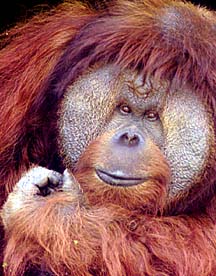
Linda Vannatta
Rusti may have to leave
to find the right home
Editor's note: City zookeeper Linda Vannatta filed suit in Circuit Court in May, asking a judge to void the state Board of Agriculture's Feb. 20 decision to allow Rusti the orangutan to be transferred to Kualoa Ranch. A hearing is scheduled Aug. 27 seeking an injunction to keep Rusti at the zoo until the lawsuit is settled.In 1997 the Orangutan Foundation International was granted permission by the Honolulu Zoo to house Rusti the orangutan "temporarily" while a sanctuary on the Big Island was built. The only space available that could hold an orangutan at that time was the zoo's old gorilla enclosure.
This enclosure was constructed 50 years ago when little was known about the natural behavior or needs of the great apes, a group consisting of chimpanzees, gorillas and orangutans.
STAR-BULLETIN / 1999
Rusti sits in his cage at the Honolulu Zoo.
Since then, we have learned a great deal about these highly intelligent and human-like primates.
In the 1970s, three scientists, Jane Goodall, Diane Fossey and Birute Galdikas, traveled to the forests of Africa and Asia to study the great apes. Their observations taught us that these animals exhibit intellectual abilities, long thought to be unique to humans, such as self-awareness, tool making and use, problem solving and the ability to plan ahead.
In her autobiography, Galdikas describes how orangutans live 50 feet or more in the forest canopy, and rarely descend to the forest floor. They are semi-social animals, and have a long mother- offspring dependency. Every night they build new sleeping nests of leaves and twigs high in the trees. While some groups of orangutans build simple nests, other groups build elaborate two story structures complete with rain shelters.
Modern zoos and reputable sanctuaries now build primate enclosures to replicate natural habitats. Stereotypical behaviors of captive apes, such as pacing or brooding in a corner, are slowly being replaced by normal behaviors such as climbing, socializing and foraging because of improved exhibits and understanding.
The American Association of Zoos and Aquariums has developed the Great Ape Taxon Advisory Group for accredited zoos. They advise on enclosure requirements and social groupings of great apes. They recommend that an adult male orangutan be housed with at least two or more related adult female orangutans, that the enclosures are spacious and are built away from loud noises. Public viewing should be allowed from one side only, and the animals on display should have a visual escape from the stares of visitors.
In addition to enclosure improvements, security, veterinary medicine and staff training have come a long way, too. Staff members are painstakingly trained in animal escape procedures and the transmission of zoonotic diseases. Zookeepers are routinely tested, as well as the primates, for tuberculosis. To prevent the spread of disease by rodents, night enclosures are rat-proofed.
Rusti's "temporary" stay at the zoo has stretched into six long years. He has patiently waited, without complaint, in a substandard enclosure. Since it is questionable that an orangutan sanctuary will ever materialize in Hawaii, we need to revisit the option of sending him back to the mainland to a reputable facility that will meet his lengthy list of needs, including a climbing structure and the companionship of a female orangutan.
Linda Vannatta is a zookeeper at Honolulu Zoo. She submitted this commentary as an individual, not as a city employee.
